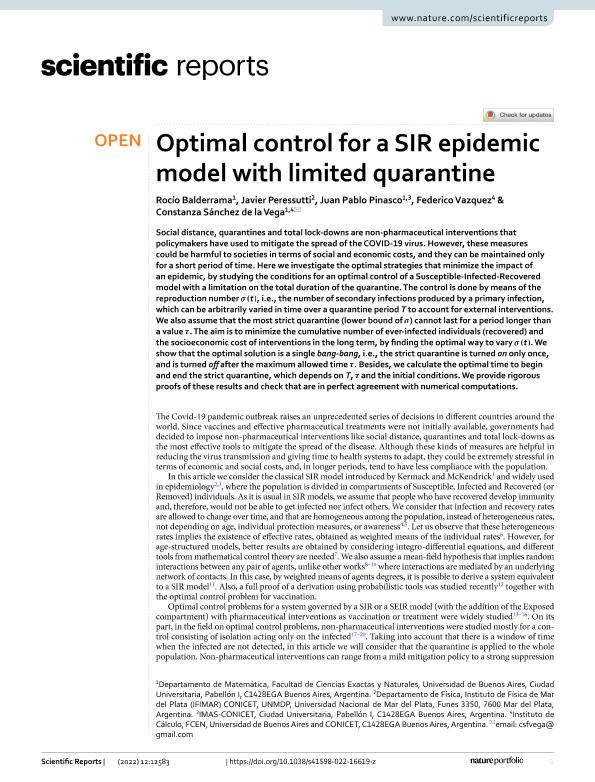Mostrar el registro sencillo del ítem
dc.contributor.author
Balderrama, Rocio Celeste

dc.contributor.author
Peressutti, Javier Hector

dc.contributor.author
Pinasco, Juan Pablo

dc.contributor.author
Vazquez, Federico

dc.contributor.author
Sanchez Fernandez de la Vega, Constanza Mariel

dc.date.available
2023-07-14T20:30:59Z
dc.date.issued
2022-07
dc.identifier.citation
Balderrama, Rocio Celeste; Peressutti, Javier Hector; Pinasco, Juan Pablo; Vazquez, Federico; Sanchez Fernandez de la Vega, Constanza Mariel; Optimal control for a SIR epidemic model with limited quarantine; Nature; Scientific Reports; 12; 1; 7-2022; 1-26
dc.identifier.issn
2045-2322
dc.identifier.uri
http://hdl.handle.net/11336/204060
dc.description.abstract
Social distance, quarantines and total lock-downs are non-pharmaceutical interventions that policymakers have used to mitigate the spread of the COVID-19 virus. However, these measures could be harmful to societies in terms of social and economic costs, and they can be maintained only for a short period of time. Here we investigate the optimal strategies that minimize the impact of an epidemic, by studying the conditions for an optimal control of a Susceptible-Infected-Recovered model with a limitation on the total duration of the quarantine. The control is done by means of the reproduction number σ(t) , i.e., the number of secondary infections produced by a primary infection, which can be arbitrarily varied in time over a quarantine period T to account for external interventions. We also assume that the most strict quarantine (lower bound of σ) cannot last for a period longer than a value τ. The aim is to minimize the cumulative number of ever-infected individuals (recovered) and the socioeconomic cost of interventions in the long term, by finding the optimal way to vary σ(t). We show that the optimal solution is a single bang-bang, i.e., the strict quarantine is turned on only once, and is turned off after the maximum allowed time τ. Besides, we calculate the optimal time to begin and end the strict quarantine, which depends on T, τ and the initial conditions. We provide rigorous proofs of these results and check that are in perfect agreement with numerical computations.
dc.format
application/pdf
dc.language.iso
eng
dc.publisher
Nature

dc.rights
info:eu-repo/semantics/openAccess
dc.rights.uri
https://creativecommons.org/licenses/by/2.5/ar/
dc.subject
SIR
dc.subject
COVID-19
dc.subject
Quarantine
dc.subject.classification
Matemática Aplicada

dc.subject.classification
Matemáticas

dc.subject.classification
CIENCIAS NATURALES Y EXACTAS

dc.title
Optimal control for a SIR epidemic model with limited quarantine
dc.type
info:eu-repo/semantics/article
dc.type
info:ar-repo/semantics/artículo
dc.type
info:eu-repo/semantics/publishedVersion
dc.date.updated
2023-07-03T16:20:20Z
dc.journal.volume
12
dc.journal.number
1
dc.journal.pagination
1-26
dc.journal.pais
Reino Unido

dc.description.fil
Fil: Balderrama, Rocio Celeste. Universidad de Buenos Aires. Facultad de Ciencias Exactas y Naturales. Departamento de Matemática; Argentina. Consejo Nacional de Investigaciones Científicas y Técnicas; Argentina
dc.description.fil
Fil: Peressutti, Javier Hector. Consejo Nacional de Investigaciones Científicas y Técnicas. Centro Científico Tecnológico Conicet - Mar del Plata. Instituto de Investigaciones Físicas de Mar del Plata. Universidad Nacional de Mar del Plata. Facultad de Ciencias Exactas y Naturales. Instituto de Investigaciones Físicas de Mar del Plata; Argentina
dc.description.fil
Fil: Pinasco, Juan Pablo. Universidad de Buenos Aires. Facultad de Ciencias Exactas y Naturales. Departamento de Matemática; Argentina. Consejo Nacional de Investigaciones Científicas y Técnicas. Centro Científico Tecnológico Conicet - San Luis. Instituto de Matemática Aplicada de San Luis "Prof. Ezio Marchi". Universidad Nacional de San Luis. Facultad de Ciencias Físico, Matemáticas y Naturales. Instituto de Matemática Aplicada de San Luis "Prof. Ezio Marchi"; Argentina
dc.description.fil
Fil: Vazquez, Federico. Universidad de Buenos Aires. Facultad de Ciencias Exactas y Naturales. Instituto de Calculo. - Consejo Nacional de Investigaciones Científicas y Técnicas. Oficina de Coordinación Administrativa Ciudad Universitaria. Instituto de Calculo; Argentina
dc.description.fil
Fil: Sanchez Fernandez de la Vega, Constanza Mariel. Universidad de Buenos Aires. Facultad de Ciencias Exactas y Naturales. Departamento de Matemática; Argentina. Universidad de Buenos Aires. Facultad de Ciencias Exactas y Naturales. Instituto de Calculo. - Consejo Nacional de Investigaciones Científicas y Técnicas. Oficina de Coordinación Administrativa Ciudad Universitaria. Instituto de Calculo; Argentina
dc.journal.title
Scientific Reports
dc.relation.alternativeid
info:eu-repo/semantics/altIdentifier/url/https://www.nature.com/articles/s41598-022-16619-z#citeas
dc.relation.alternativeid
info:eu-repo/semantics/altIdentifier/doi/https://doi.org/10.1038/s41598-022-16619-z
Archivos asociados
